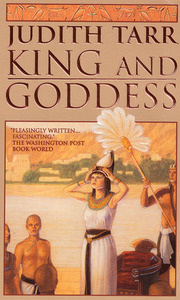Take a photo of a barcode or cover
A fictional telling of the life of the real female pharaoh Hatsheput. Entertaining with vivid imagery.
A good novel based on the life of Hatshepsut. Tarr's is different enough from Gedge's Child of Morning that each stands out.
dark
emotional
informative
inspiring
slow-paced
Plot or Character Driven:
Character
Loveable characters:
Complicated
Good story. Its tough to find a book set in ancient Egypt that isn't focused just on the pharaoh and royal society, but this one did a good job of giving a little bit of a look at the more common man. Slow to start, but It drew me in as the story progressed.
I’ve been reading a lot of novels’ interpretations of Hatshepsut recently, and Judith Tarr’s book, if nothing else, puts a distinctly different spin on the story than others. The first thing to note is that, yes, this book was published in 1996, and that means it is stuffed full of Hatshepsut tropes that have been long since overturned in Egyptology as new evidence has come to light. These include the idea that Thutmose III had an antagonistic relationship with Hatshepsut – even though, in the author’s note, Tarr recognises that it is odd that he didn’t destroy Hatshepsut’s monuments until decades after her death; she nevertheless says he turned on her ‘suddenly’ and ‘viciously’, whilst most Egyptologists consider the lengthy gap to indicate that it was a political rather than personal matter. Other outdated ideas include the notion that Hatshepsut as a female ruler concerned herself only with peaceful pursuits – current evidence suggests otherwise, and the idea is grounded in antiquated perceptions of female rulership as inherently nurturing – and the Heiress Theory, which was the notion that while kings ruled in Egypt they ruled by right of the royal women who carried the bloodline and hence always had to marry their sisters. In fact these models were long since recognised as incorrect a good decade or so before Tarr wrote this novel, but I guess it takes time for myth-busting to reach the popular consciousness from the original research community. Tarr throws in a forbidden romance with Senenmut too but to be fair I have yet to read a single Hatshepsut novel, published in the past five years or several decades ago, that didn’t throw in a romance with Senenmut, despite the gaping hole of evidence for it. A lot of novelists simply seem to consider it dramatic fodder far too good to pass up.
That said, King and Goddess does buck quite a few of the Hatshepsut tropes. Her daughter, Neferure, is usually depicted as a frail wallflower who dies young as a result. Neferure here is no shrinking violet, and whilst she still dies young, it is due to her strong-willed and forceful actions. The book also shows Hatshepsut and the concubine as allies, at least initially, and Thutmose II as not nearly as much of a bad guy as most Hatshepsut novels portray him as. This provided me with an interesting and fresh take on events, compared to the Hatshepsut books I’ve read up to this point. And, to some extent, the above-mentioned historical inaccuracies are forgivable precisely because of how far back this book was written. The modern e-book edition contains a second author’s note dating from 2015, in which Tarr highlights the latest research and says that she would’ve written the story differently had she known, particularly the relationship between Hatshepsut and her step-son, and the manner of Hatshepsut’s end.
As far as style of writing goes, it has a mature, competent baseline that reminds me of Stephanie Thornton’s Daughter of the Gods, but it is at once different. Thornton has a skill for creative description that, while she doesn’t use it consistently, reminds me a lot of Pauline Gedge and is something I feel she should use more. Judith Tarr lacks that creative flair, and her prose never excited me, but it was solid throughout, and I noticed that she has an interesting penchant for throwing in archaic words here and there. I thought the pacing was good, one of the better ones among Hatshepsut novels actually. A lot of focus is spent on building up the early dynamic between Hatshepsut and Senenmut, so it feels like the book earns their relationship rather than just flinging these two characters together because that’s just what Hatshepsut novels do. At the same time, it doesn’t seem to take away from a meaty section of the book spent on Hatshepsut as pharaoh, which I feel should always be the core of any Hatshepsut story.
One final point is that I felt Tarr portrayed basic societal attitudes better than either Stephanie Thornton or Libbie Hawker’s books, which at times felt a bit mirror-like in their reflection of modern values. Tarr is starker about the treatment of women, and the huge gulf between royalty and commoner – and she’s right. I feel that too many ancient Egypt novels recently have failed to understand the chasm of status, wealth, and social circles. I note that a few reviewers felt that Tarr doesn’t portray Hatshepsut very well in this book, that the character is too aloof, but for me it was an accurate measuring of that vast distance, and as far as I can see Hatshepsut, although a main character, isn’t supposed to be the protagonist. This is actually Senenmut’s story, and I thought it did a pretty good job of telling it.
Could the book have been better? Yes. As I said, the writing never really amazed or enraptured me, although it was pleasantly competent throughout. Occasionally the book veered into over-the-top, hackneyed stock characters, probably because it drew from those three very outdated hypotheses about Hatshepsut. However, the pacing was good, the ambience was fairly well done, the characters were mostly well-developed and earned their pay-offs, and the novel does offer a few fresh twists that I haven’t seen in other Hatshepsut novels before.
7 out of 10
That said, King and Goddess does buck quite a few of the Hatshepsut tropes. Her daughter, Neferure, is usually depicted as a frail wallflower who dies young as a result. Neferure here is no shrinking violet, and whilst she still dies young, it is due to her strong-willed and forceful actions. The book also shows Hatshepsut and the concubine as allies, at least initially, and Thutmose II as not nearly as much of a bad guy as most Hatshepsut novels portray him as. This provided me with an interesting and fresh take on events, compared to the Hatshepsut books I’ve read up to this point. And, to some extent, the above-mentioned historical inaccuracies are forgivable precisely because of how far back this book was written. The modern e-book edition contains a second author’s note dating from 2015, in which Tarr highlights the latest research and says that she would’ve written the story differently had she known, particularly the relationship between Hatshepsut and her step-son, and the manner of Hatshepsut’s end.
As far as style of writing goes, it has a mature, competent baseline that reminds me of Stephanie Thornton’s Daughter of the Gods, but it is at once different. Thornton has a skill for creative description that, while she doesn’t use it consistently, reminds me a lot of Pauline Gedge and is something I feel she should use more. Judith Tarr lacks that creative flair, and her prose never excited me, but it was solid throughout, and I noticed that she has an interesting penchant for throwing in archaic words here and there. I thought the pacing was good, one of the better ones among Hatshepsut novels actually. A lot of focus is spent on building up the early dynamic between Hatshepsut and Senenmut, so it feels like the book earns their relationship rather than just flinging these two characters together because that’s just what Hatshepsut novels do. At the same time, it doesn’t seem to take away from a meaty section of the book spent on Hatshepsut as pharaoh, which I feel should always be the core of any Hatshepsut story.
One final point is that I felt Tarr portrayed basic societal attitudes better than either Stephanie Thornton or Libbie Hawker’s books, which at times felt a bit mirror-like in their reflection of modern values. Tarr is starker about the treatment of women, and the huge gulf between royalty and commoner – and she’s right. I feel that too many ancient Egypt novels recently have failed to understand the chasm of status, wealth, and social circles. I note that a few reviewers felt that Tarr doesn’t portray Hatshepsut very well in this book, that the character is too aloof, but for me it was an accurate measuring of that vast distance, and as far as I can see Hatshepsut, although a main character, isn’t supposed to be the protagonist. This is actually Senenmut’s story, and I thought it did a pretty good job of telling it.
Could the book have been better? Yes. As I said, the writing never really amazed or enraptured me, although it was pleasantly competent throughout. Occasionally the book veered into over-the-top, hackneyed stock characters, probably because it drew from those three very outdated hypotheses about Hatshepsut. However, the pacing was good, the ambience was fairly well done, the characters were mostly well-developed and earned their pay-offs, and the novel does offer a few fresh twists that I haven’t seen in other Hatshepsut novels before.
7 out of 10
This is a novel about the rise and rule of King Hatshepsut. What makes this novel unique is that the majority of the novel is told through the POV of Senenmut. Senenmut is a historical figure associated with King Hatshepsut. There are also smaller sections told through the POV of Nehsi, another member of King Hatshepsut's inner circle.
The story of Hatshepsut is very familiar to me and there are various ideas of the specifics of how things unfolded. I found most of the information/character development and personalities plausible. There was nothing that stood out as wildly historically inaccurate based on what we know about Hatshepsut and the people in her life.
Excellent read.
The story of Hatshepsut is very familiar to me and there are various ideas of the specifics of how things unfolded. I found most of the information/character development and personalities plausible. There was nothing that stood out as wildly historically inaccurate based on what we know about Hatshepsut and the people in her life.
Excellent read.
I found this to be a richly woven historial novel. Judith Tarr has a way of writing historical women as strong and capable without removing all vestiges of what makes them women. In this tale, a woman declares herself King - a very male role to hold. Through it all, she maintains her independence. The only thing that keeps this from being a 5-star from me is that I feel I've read the same plot from the same author before. Not that it makes it less worthy of reading, just that it feels a lot like her other novels.
King and Goddess is a well-written, engaging novel that brings Ancient Egypt in the reign of Hatshepsut to life. Unfortunately, I had a lot of niggles with it that meant that I didn't enjoy it as much as I feel that I have should have.
Early on, I found both Hatshepsut and Senenmut unsympathetic and unlikeable characters. In the early chapters, both are limited to ambitious and arrogant, before Hatshepsut developed a cruel streak. In one scene, Hatshepsut refuses to have anything to do with her newborn daughter, Neferure, because she is not the son. In another, Hatshepsut seems inordinately cruel to her husband, Thutmose II, who Tarr depicts as having loved, or was in love with, Hatshepsut.
It's possible, of course, that Hatshepsut was really an ambitious, cruel and arrogant woman – but it's hard to take these qualities and create a heroine that we're meant to root for. Particularly, when, Tarr's Thutmose II is far from unlikeable enough that Hatshepsut's cruelty towards him come across as warranted or necessary.
I was disappointed by Isis, the mother of Thutmose III, and the relationship she has with Hatshepsut. Initially, they are depicted in a kind of alliance with Hatshepsut, but this quickly develops into an one-sided rivalry, with Isis as a petty, jealous concubine to Hatshepsut as the munificent queen.
I was disappointed by Isis, the mother of Thutmose III, and the relationship she has with Hatshepsut. Initially, they are depicted in a kind of alliance with Hatshepsut, but this quickly develops into an one-sided rivalry, with Isis as a petty, jealous concubine to Hatshepsut as the munificent queen.
Hatshepsut and Senemut do become more than arrogantly ambitious, but we're never shown them growing as characters. Still, I had issues with Tarr's Hatshepsut right until the end. Her blindness and hatred when it comes to Thutmose III are majorly off-putting. Her own ambitions are never developed beyond her belief that she, alone, is worthy of the kingship.
Again, I found myself disappointed by the relationship between Hatshepsut and her heir, Thutmose III. The relationship was once thought to have been one of mutual hatred is known today to be far more complex. It is possible that Thutmose III had great respect for his aunt, stepmother and co-regent. Today, it seems more likely that that his actions were driven by the desire to safeguard his son's succession than hatred and resentment towards his aunt.
I felt as though the character of Thutmose III was wasted somewhat. Tarr gave us an uniquely awesome look at him as a child, but didn't really go anywhere after that.
The story is told mostly through the eyes of Senenmut, though Tarr occasionally offers a small scene through the eyes of Nehsi, the chancellor/guard of Hatshepsut. For the most part, this works. We're allowed extra insight into Hatshepsut and other characters, and it provides a natural way to continue the novel after Senenmut's death. But, it felt out of place and particularly uneven when the story switches to Nehsi and the voyage to Punt for several chapters, keeping the reader away from both Senenmut and Hatshepsut.
The book was published in 1996, and in some ways it shows its age, such as in Hatshepsut's pacifism and the largely antagonistic relationship she has with Thutmose III.
King and Goddess is a fantastic read, one that I would happily recommend. For me, it's disappointing and a little uneven, but this probably more a reflection of my own knowledge and attitudes towards Hatshepsut and Thutmose III than anything else. 3.5 stars.
Early on, I found both Hatshepsut and Senenmut unsympathetic and unlikeable characters. In the early chapters, both are limited to ambitious and arrogant, before Hatshepsut developed a cruel streak. In one scene, Hatshepsut refuses to have anything to do with her newborn daughter, Neferure, because she is not the son. In another, Hatshepsut seems inordinately cruel to her husband, Thutmose II, who Tarr depicts as having loved, or was in love with, Hatshepsut.
It's possible, of course, that Hatshepsut was really an ambitious, cruel and arrogant woman – but it's hard to take these qualities and create a heroine that we're meant to root for. Particularly, when, Tarr's Thutmose II is far from unlikeable enough that Hatshepsut's cruelty towards him come across as warranted or necessary.
I was disappointed by Isis, the mother of Thutmose III, and the relationship she has with Hatshepsut. Initially, they are depicted in a kind of alliance with Hatshepsut, but this quickly develops into an one-sided rivalry, with Isis as a petty, jealous concubine to Hatshepsut as the munificent queen.
I was disappointed by Isis, the mother of Thutmose III, and the relationship she has with Hatshepsut. Initially, they are depicted in a kind of alliance with Hatshepsut, but this quickly develops into an one-sided rivalry, with Isis as a petty, jealous concubine to Hatshepsut as the munificent queen.
Hatshepsut and Senemut do become more than arrogantly ambitious, but we're never shown them growing as characters. Still, I had issues with Tarr's Hatshepsut right until the end. Her blindness and hatred when it comes to Thutmose III are majorly off-putting. Her own ambitions are never developed beyond her belief that she, alone, is worthy of the kingship.
Again, I found myself disappointed by the relationship between Hatshepsut and her heir, Thutmose III. The relationship was once thought to have been one of mutual hatred is known today to be far more complex. It is possible that Thutmose III had great respect for his aunt, stepmother and co-regent. Today, it seems more likely that that his actions were driven by the desire to safeguard his son's succession than hatred and resentment towards his aunt.
I felt as though the character of Thutmose III was wasted somewhat. Tarr gave us an uniquely awesome look at him as a child, but didn't really go anywhere after that.
The story is told mostly through the eyes of Senenmut, though Tarr occasionally offers a small scene through the eyes of Nehsi, the chancellor/guard of Hatshepsut. For the most part, this works. We're allowed extra insight into Hatshepsut and other characters, and it provides a natural way to continue the novel after Senenmut's death. But, it felt out of place and particularly uneven when the story switches to Nehsi and the voyage to Punt for several chapters, keeping the reader away from both Senenmut and Hatshepsut.
The book was published in 1996, and in some ways it shows its age, such as in Hatshepsut's pacifism and the largely antagonistic relationship she has with Thutmose III.
King and Goddess is a fantastic read, one that I would happily recommend. For me, it's disappointing and a little uneven, but this probably more a reflection of my own knowledge and attitudes towards Hatshepsut and Thutmose III than anything else. 3.5 stars.


